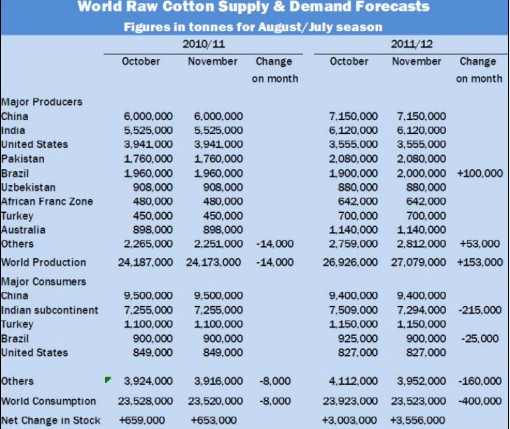|
LAHORE (June 18 2010): Due to record high prices which the growers received for seedcotton (Kapas/Phutti) during the outgoing season (2009-2010), sowing of cotton has been early as well as extensive. Various estimates put the new crop (2010-2011) sowing in Pakistan to be about 10 to 15 percent more than the previous season (August 2009 - July 2010). All the cultivatable area has already been sown and now the early varieties are showing their debut in several stations in Punjab, and also in Sindh to a lesser degree, in moderate quantities. In Punjab seedcotton (Kapas/Phutti) in quantities ranging from 10 to 15 maunds (37.32 Kgs), are arriving daily in such areas like Harunabad, Bureawalla, Sahiwal, Chichawatni, Depalpur and Khanewal. Seedcotton from the new crop has also started arriving in a few area in Sindh which is reportedly being dispatched to Punjab where some factories have already prepared to start ginning immediately. Thus seedcotton (Kapas/Phutti) has started trickling in at various mandis (Market Towns) which is a good omen for the new season (August 2010 - July 2011). Some seedcotton from Sindh carries a modicum of moisture compared to the Punjab seedcotton. Thus new crop seedcotton from Sindh is selling from Rs 2500 to Rs 2600 per 40 kgs, but Punjab seedcotton is selling at a higher rate in the range of Rs 2700 to Rs 2900 per 40 kgs, according to the quality. In the evening it was reported that a small quantity of seedcotton from Sahiwal sold at the record price of Rs 3050 per 40 kilogrammes. Basically speaking, cotton prices are steady in the domestic market and also quite firm in the global markets. Such a scenario is expected to persist because cotton supplies are generally less than the current and impending demand for the foreseeable future with little carryover from the current to the new crop. Presently the spinning industry is facing several hardships following imposition of the Regulatory Duty (RD) on the exports of yarns, but it should hopefully come out of its predicament next month with the expected lapse of the RD. It is expected that as soon as the value added textile sector which was facing steep rise in yarn prices becomes attuned and adjusted with the high prices of cotton and yarns which are prevailing globally, the functioning of both the spinning industry as well as the downstream industries will align themselves more adequately during the forthcoming months. Presently, however, the domestic yarn prices are on the weaker side. In current crop (2009-2010) styles, Sindh cotton was being quoted from Rs 6,200 to Rs 6,600 per maund, while lint from Punjab was being offered variously between Rs 6,500 to Rs 6,700 per maund (37.32 kgs) according to the quality. From the new crop (2010-2011), 100 bales of lint from Pakpattan was reportedly sold on Thursday at Rs 6,300 per maund with delivery stipulation being on 21 June 2010. It may be recalled that about three weeks ago 200 bales of new crop cotton from Harunabad were sold at Rs 5,500 per maund (37.32 kgs) with delivery scheduled between the tenth and the 15th of July 2010. Thus it is surmised that a few factories will start ginning new crop (2010-2011) cotton within the next week or ten days time. More factories are also expected to start ginning over the next few weeks. New crop cottonseed (Binola/Kakra) which was selling at Rs 1,040 per maund (37.32 kgs) was quoted at Rs 1,000 per maund on Thursday. Under the circumstances, new crop (2010-2011) in Pakistan is projected to yield between 13.5 to 14 million bales of domestic size on an ex-gin basis. Against this output, domestic mills are likely to consume between 15.25 to 15.50 local size bales. With these provisions, Pakistan will needfully import around two million domestic size bales during the forthcoming season (2010-2011). Pakistanis mills have good connections with cotton suppliers around the world including USA, Brazil, West Africa, Australia, the CIS (Commonwealth of Independent States) and India. Reliable shippers will be approached for regular supplies throughout the forthcoming season for the import of the desired styles and quantities into Pakistan accordingly. It was learnt that India has allowed resumption of cotton export which was earlier withheld due to certain restrictions and export levies. Once the modalities and other details have been sorted out, pending cotton shipments from India may start again. On the global economic and financial front, the equity markets again perked up at midweek to show positive gains despite a torrent of bad news emanating from different corners of the world. As anticipated, if Greece was accommodated with a massive bailout of nearly Dollars 150 billions, could Spain be far behind? Now Spain is heading for a calamitous economic and financial breakdown also needing the infusion of colossal dose of bailout money. The BP oil well spill under the sea in the Gulf of Mexico is now being projected as a global disaster expected to have adverse implications being valued at nearly one trillion United States dollars. Indeed other European countries like Singapore are already downsizing their export prospects to Europe. In the United States, trade deficit again widened in April 2010. Thus the Euro zone leaders were again assembling together to find ways and means to forestall further decline in their sick economies. These sings and signals point to a worsening global economic condition which shows no sign of abatement. Most leading countries of the world have become technically bankrupt and thus a megamess of economic maladministration, overindulgence, faulty practices and procedures in banking and the commodity markets has resulted in what promises to be a painful period ahead for the global economic and sociopolitical system. With the deteriorating economic and financial sectors around the world, many hallowed business institutions and sacred cows of the prevailing economic architecture are facing unprecedented criticism regarding their efficacy and validity. In this context, one must note that other role models like China, Brazil, India are emerging which may yet implant their beneficial footprints on the global socio-economic and political landscape. |
|
New cotton crop arrivals on the anvil
Updated: 2010-6-18 Source: Texglobe-ÐÅÏ¢ÖÐÐÄ

Recommended News
Photo Gallery
Most Popular



